- 1Montana State University Food and Health Lab, Department of Health and Human Development, Montana State University, Bozeman, MT, United States
- 2Department of Agricultural and Technology Education, Montana State University, Bozeman, MT, United States
Elementary education can equip future consumers and leaders with the systems thinking skills, real-world experiences, and knowledge to make decisions and lead progress toward sustainability transitions. The implementation of learning standards that focus on sustainability is one approach for integrating sustainability and food systems content into elementary education. The purpose of this study was to administer a survey with elementary-level educators to: (1) identify practices and perceptions of integrating sustainability and food systems concepts into the classroom; and (2) determine if practices and perceptions vary based on the presence of state learning standards focused on sustainability. A total of 171 educators completed the majority of the survey from two northwestern states in the United States: Washington (which has state learning standards focused on sustainability) and Montana (which does not have sustainability learning standards). Findings that 30% or less of the surveyed educators integrate sustainability and food systems content in their classroom highlights the urgent need for reforming elementary school curriculum to integrate sustainability as a central unifying framework to support societal and planetary health. Given the similarities in survey responses between educators in Washington and Montana, findings emphasize that state learning standards focused on sustainability are not adequate on their own to foster teacher adoption of sustainability content. There is thus a need for larger curriculum reformation to integrate sustainability as a framework, development of place-based teacher resources, and open access professional development to ensure that elementary-school students cultivate the systems thinking skills, real world experience, and knowledge that will allow them to develop the competencies to ultimately guide society toward meeting the Sustainable Development Goals of the United Nations.
Introduction
Human activities are having unprecedented impacts on Earth's systems (Steffen et al., 2015) with sustainability challenges in every sector of society, including food systems. The complex social, environmental, economic, and health interactions that comprise food systems have dramatic impacts on human and planetary health (Willett et al., 2019). For example, the food system accounts for ~30% of total global greenhouse gasses emissions which contribute to climate change (Mason and Lang, 2017). In turn, climate change impacts agricultural productivity and food security (Mason and Lang, 2017). While food production and sales support farmer livelihoods and the economy, food access is an economic challenge for ~26% of the global population who experience some level of food insecurity annually (Food Agriculture Organization, 2019). Food insecurity places the population at further risk of being malnourished with associated poor health outcomes (Food Agriculture Organization, 2019). Unhealthy diets are among the largest contributors to the global burden of disease (Gakidou et al., 2017), with an estimated two billion adults overweight and obese worldwide (World Health Organization, 2020). Given the challenges of food systems and other societal activities, advancing sustainability is critical for ourselves, future generations, and the planet.
In recognition of the need to enhanced sustainability, multiple national and global policy platforms have advanced strategies to promote sustainability. For example, the United Nations has developed and implemented Education for Sustainable Development and the Sustainable Development Goals (SDGs). Sustainable development describes a way of living in which humanity meets their economic and social needs in a culturally appropriate manner, without inhibiting the ability of future generations to meet their own needs (World Commission on Environment Development, 1987). Education for Sustainable Development is a pedagogical model that takes a learner-centered approach and integrates sustainability content across subject areas (UNESCO, 2014). The SDG's include 17 guideposts toward developing a more sustainable world by 2030 including ending hunger, creating affordable and clean energy, mitigating climate change, ensuring equitable and available education, supporting sustainable consumption and production patterns, and halting biodiversity loss among others (United Nations, 2015).
Education can serve a crucial role in sustainability transitions for society that balance environmental, economic, health, and social well-being goals (Sarabhai, 2015). The early stage of formal education, known as elementary or primary education (that generally encompasses kindergarten through fifth or sixth grade), plays a pivotal role in preparing future consumers and leaders with the systems thinking skills, real world experiences, knowledge, and motivation to lead sustainability transitions (Church and Skelton, 2010; Sarabhai, 2015). However, there remains a to need to understand how to effectively integrate sustainability into the elementary education classroom.
The implementation of learning standards is one approach for integrating sustainability and food systems content into elementary education. In addition, pedagogical models focused on sustainability are another approach for integrating sustainability into the elementary education classroom. Moreover, pedagogical models focused on sustainability can inform the development of learning standards as well as curriculum and assessments. In the United States, only two states, Washington and Wisconsin, have explicit state learning standards that focus on sustainability to guide curriculum (Wheeler et al., 2014; Wisconsin Department of Public Instruction, 2018). In most other states, sustainability topics are most commonly integrated into the elementary education curriculum by individual teachers and non-profit organizations (Church and Skelton, 2010). Two pedagogical models for informing learning standards and developing curricula that integrate sustainability are Education for Sustainable Development and the Sustainable Food Systems Education (SFSE) signature pedagogy (Valley et al., 2018). Both Education for Sustainable Development and the Sustainable Food Systems Education signature pedagogy outline methods for cultivating systems thinking skills, real world experience, and sustainability knowledge that will allow students to make changes that foster sustainability (Church and Skelton, 2010; Valley et al., 2018).
The purpose of this study is to identify elementary-school educators' practices and perceptions regarding integrating sustainability and food systems concepts in their classrooms. Research was carried out in the northwestern states of Washington and Montana in the United States (US) in order to assess whether teaching practices and perceptions vary based on the presence of formal state learning standards focused on sustainability (with Washington having state learning standards focused on sustainability and Montana not having state learning standards focused on sustainability). Through a semi-structured survey that included open-ended and close-ended questions, this study assesses educators' experiences using specific teaching methods, teaching about sustainability-related content areas, fostering necessary competencies in their students, and facing the challenges of integrating sustainability and food systems concepts into the curriculum. The survey was developed based on the pedagogical models of Education for Sustainable Development and the Sustainable Food Systems Education signature pedagogy. In addition, document analysis was carried out of Washington's Integrated Environmental and Sustainability Education Learning Standards in order to determine if they align with Education for Sustainable Development and can be used as an example of integrating sustainability. This study contributes to identifying educational strategies for integrating sustainability and sustainable food systems concepts into elementary school education in the United States in order to foster students who have the knowledge, skills, and motivation to make choices that support sustainability.
Background
Socio-Ecological Systems Theory
Socio-ecological systems theory provides a relevant foundation for sustainability education. Specifically, socio-ecological systems theory provides a foundation for studying human development where individuals' environments are related to each other and the larger social context (Bronfenbrenner, 1977). According to Bronfenbrenner's socio-ecological theory, the development of a person involves progressively more complex interactions between the person and their environments over time (Bronfenbrenner, 1986). Applying Bronfenbrenner's socio-ecological theory to sustainability education calls for progressively more complex interactions with sustainability content and projects throughout one's schooling (Bronfenbrenner, 1986). It is key that these interactions with sustainability concepts are present over time, throughout every year of schooling (Bronfenbrenner, 1986). Over the past five decades, socio-ecological systems theory has evolved to emphasize linked systems of social and biophysical factors that is applicable to examining sustainability (Berkes and Folke, 1998). Indeed, socio-ecological systems theory has extensively been applied as a framework for examining sustainability topics including sustainable food systems (Walker and Salt, 2012; Mason and Lang, 2017).
Sustainability-Focused Education Models
Spearheaded by the United Nations, Education for Sustainable Development (ESD) is a key strategy for progress toward sustainable development and meeting the SDGs (UNESCO, 2014, 2017). As an interdisciplinary and transdisciplinary educational model, ESD content and pedagogies work together to highlight the interconnectedness of the environment, the economy, and culture (UNESCO, 2012). ESD seeks to empower learners to make “informed decisions and [take] responsible actions for environmental integrity, economic viability, and a just society, for present and future generations, while respecting cultural diversity” (UNESCO, 2014). Key ESD content areas include local issues, climate change, biodiversity, sustainable consumption and production, poverty reduction, and disaster risk reduction (Leicht et al., 2018). In general, the content integrated into ESD is guided by the SDGs (United Nations, 2015).
With regards to pedagogy, ESD promotes participatory learning in a student-centered environment through issue-based, place-based, and action-oriented approaches (UNESCO, 2012). ESD pedagogies encourage students to ask questions, think critically, cooperate, collaborate, and make informed decisions through a range of teaching techniques such as storytelling, simulations, role-playing, class discussions, debates, case studies, outdoor learning, and modeling good practices (Cotton and Winter, 2010; Tilbury, 2011; UNESCO, 2012). The integration of ESD across all subject areas promotes systems-thinking and prepares students to make informed decisions in their futures.
The Sustainable Food Systems Education (SFSE) signature pedagogy (Valley et al., 2018) provides a complementary educational model to ESD in terms of providing sustainability content focused on food systems. The SFSE signature pedagogy is a conceptual model based on the following four common themes among SFSE higher-education programs: (1) collective action; (2) systems thinking; (3) experiential learning and; (4) interdisciplinarity (Valley et al., 2018). While the SFSE signature pedagogy was developed for undergraduate-level college students, it has the potential to inform elementary school education in complement with ESD. Both ESD and the Sustainable Food Systems Education signature pedagogy place an emphasis on the interdisciplinarity and focus on cultivating systems thinking across disciplines through experiential pedagogies. In addition, both ESD and the SFSE signature pedagogy place an emphasis on integrating education into the larger community through collective action or real-world projects.
Sustainability-Focused Learning Standards
Learning standards are one approach to integrate sustainability content and pedagogies such as ESD and the SFSE signature pedagogy into the classroom. For example, ESD has been integrated into the learning standards of the national curricula of a range of countries, including Australia, Costa Rica, Cyprus, Ghana, Kenya, and others (Laurie et al., 2016; UNESCO, 2017; Witoszek, 2018). The United States does not have a national curriculum and each state has local control over the development of learning standards and curriculum. Only two of the 50 states in the United States, Washington and Wisconsin, have sustainability-related standards (Wheeler et al., 2014; Wisconsin Department of Public Instruction, 2018). Both Washington and Wisconsin integrated ESD content and pedagogies in the development of their sustainability-related standards (Wheeler et al., 2014; Wisconsin Department of Public Instruction, 2018). Specifically, Washington developed Environmental and Sustainability Education Learning Standards (ESE Learning Standards) for grades K-12 in 2009 in accordance with a law requiring environmental education throughout the state (Wheeler et al., 2014). The ESE Learning Standards are designed to be integrated across disciplines at all grade levels and focus on the following: (1) knowledge of the interconnections and interdependency of ecological, social, and economic systems; (2) opportunities to engage in inquiry and systems thinking that can be applied to natural and human-built environments and; (3) ability to make personal and collective decisions and take actions that promote sustainability (Wheeler et al., 2014).
Methods
Study Sites
This study included two states in the northwestern United States: Washington and Montana. Washington was selected for its implementation of sustainability-focused learning standards while Montana was selected as a state close to Washington that does not have sustainability-focused state learning standards. Both states are characterized by large expanses of agricultural land (Montana Department of Agriculture, 2019; Washington Department of Agriculture, 2019). Washington has an area (71,362 square miles) that is roughly half the size of the state of Montana (47,164 square miles) while Washington has a population (6,724,540 people) that is over seven times that of Montana (989,415 residents) (United States Census Bureau, 2012). The Washington and Montana public-school system are managed by an office of public instruction, which develops and sets the learning standards for the states. Washington has a set of standards for K-12 Environmental and Sustainability Education, while Montana does not (Montana Office of Public Instruction, 2020b; Washington Office of the Superintendent of Public Instruction, 2020b). Washington has 1,041 public elementary (K−5) schools, while Montana has 446 (Montana Office of Public Instruction, 2020a; Washington Office of the Superintendent of Public Instruction, 2020a).
Survey Instruments
Survey tools were developed and administered to elementary school teachers in Washington and Montana. Both surveys were designed based upon ESD and the SFSE signature pedagogy. The survey instruments administered in each location were the same except the Washington version had a section on their sustainability-focused learning standards (the ESE Standards). The survey instruments were reviewed for face validity by content experts in the fields of sustainable food systems, agriculture, and education. The survey tool was pilot tested for validity with five elementary school teachers in two Washington counties and was modified for clarity based on feedback.
The final survey instrument administered to teachers in Washington (Supplementary Material: Survey Instrument for Washington) contained 20 multiple-choice, Likert scale, and open-ended questions divided into three sections: (1) Background Questions; (2) Teaching Practices and; (3) ESE Learning Standards. Section one included demographic questions, including what grade the participant teaches, how many years they have been teaching, and what county they teach in. This section also asked teachers how much they knew about the state's ESE Standards, how they define sustainability, and what type of training they have received related to sustainability education. The second section included questions about the teaching methods participants use, what sustainability-related content participants teach, and what competencies participants strive to achieve in their students. The answer options for questions in this section were drawn from ESD documents and the SFSE signature pedagogy (UNESCO, 2012, 2014, 2017; Valley et al., 2018). The final section of the survey asked teachers how well they believe they met each of the three ESE Standards in their classrooms and to provide an example of how they met each ESE Standard in their classrooms.
The survey instrument administered to teachers in Montana (Supplementary Material: Survey Instrument for Washington) removed all mentions of the ESE Standards and thus included one less question compared to the Washington survey (19 total questions). Additionally, when teachers were asked how well they met each of Washington's ESE Standards, the standards were presented to participants as learning outcomes.
Exempt approval for human subjects to participate in this study was received from the Institutional Review Board at Montana State University prior to the distribution of the survey instruments. All participants provided informed consent prior to completing the survey and were offered a $15 incentive for completing a majority of the survey. The surveys were created online in Qualtrics XM (www.qualtrics.com) and distributed via email to elementary (grades K – 5) teachers at public schools in Washington and Montana. The sample group of teachers was selected using publicly available lists of all public elementary schools in the two states. For each state, a sample of 30 schools was selected using stratified random sampling. A random number generator was used to select 15 Title I schools and 15 non-Title I schools from a list of all public elementary schools in each state. The appropriate survey was emailed to every K-5 regular-classroom teacher at each of the 60 selected elementary schools using publicly available email addresses from the schools' websites. The survey was distributed to 610 teachers at 30 schools across Washington and to 362 teachers at 30 schools across Montana.
For the purpose of this research, the Title I designation included schools that are enrolled in a Title I school wide program, not a targeted assistance program. In order for a school to qualify for the Title I school wide program, >40% of students must be low income (US Department of Education, 2018). Therefore, this stratified sampling method ensured that lower-income and higher-income schools were equally represented in the sample, as economic status may impact the ability of a school to focus on teaching about sustainability. The random selection of schools within the strata ensured that a representative sample of schools and teachers across each state were included in the sample. Other demographic data, including school size and county, were collected in the survey so that their impact on sustainability education could be elucidated in the analysis.
In order to participate in the survey, an individual was required to be employed as a K-5 classroom teacher in a public school in either Washington or Montana that do not teach special classes such as gym classes, music classes, language classes, or special education classes.
Document Analysis of Learning Standards
An analysis of the ESE Standards was conducted in order to assess whether Washington's ESE Standards reflect the content and pedagogies associated with ESD and the SFSE signature pedagogy. The ESE Standards (Wheeler et al., 2014) are outlined in a publicly available document on the Office of the Superintendent of Public Instruction's website. This document was systematically analyzed, as described by Bowen (2009). A deductive framework (Supplementary Material: Document Analysis Framework) for analysis was developed that highlights key ESD content, pedagogies, and competencies, as described by the United Nations (UNESCO, 2014; Leicht et al., 2018) as well as key elements of the SFSE signature pedagogy (Stoy et al., 2018; Valley et al., 2018). The framework consists of a table that features each of these ESD and SFSE elements. The framework was applied to code the ESE Standards document to analyze the extent to which the ESD and SFSE elements are present in Washington's ESE Standards. For each ESD or SFSE element that was present, the appropriate quotation from the ESE Standards was copied into the table to demonstrate its inclusion.
Data Analysis
Participants that completed <75% of the survey or did not qualify to complete the survey (based on their answers to background questions) were removed from the sample. Then, quantitative data was analyzed using the JMP (JMP® SAS Institute Inc., Cary, NC, USA) statistical software program. T-tests were completed to compare differences among teachers in Washington and Montana. Analysis of Variance (ANOVA) was completed to compare differences among teachers in different demographic groups, including state, grade-level taught, and school's Title I status. The Pearson p-value is reported for significant (p < 0.05) differences in survey responses among groups of teachers.
Responses to open-ended questions were coded by two researchers using an inductive coding approach (Saldaña, 2015). After the lead researcher developed a codebook, both the lead researcher and a second researcher coded all open-ended responses and resolved all discrepancies. The frequencies of themes were then tabulated.
Results
Demographics
In Washington, 112 teachers completed or partially completed the survey, resulting in a final sample size of 87 participants from Washington (14.3% response rate; only participants that completed 75% or more of the survey were included in the sample). In Montana, 107 teachers completed or partially completed the survey, resulting in a final sample size of 84 participants from Montana (23.2% response rate). The demographic characteristics of participants from each state are detailed in Table 1. The associations between survey responses and educators' states, grades taught, and schools' Title I status are discussed throughout this section. The associations between survey responses and years teaching and rurality were not significant and are thus not discussed in this section.
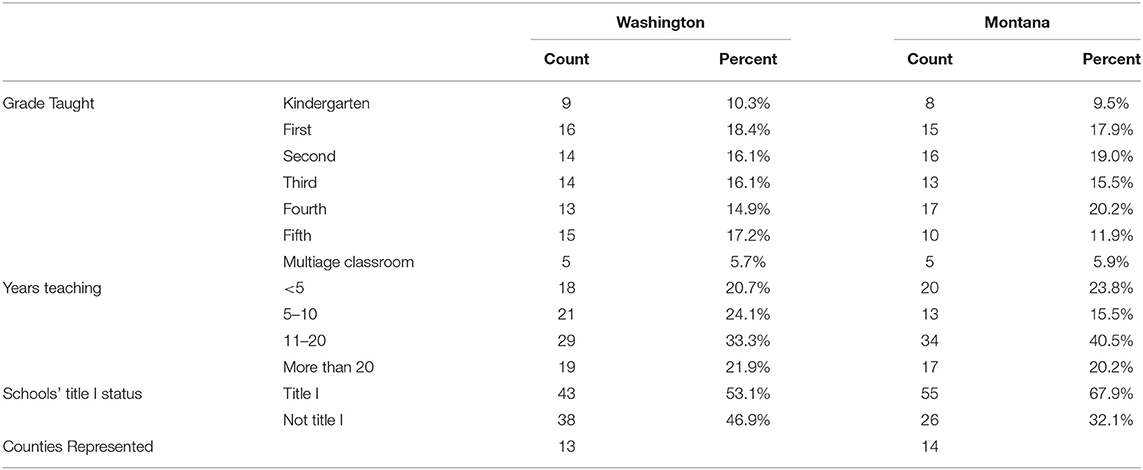
Table 1. Demographic characteristics of participants from Washington and Montana. Percentages listed indicate the percent of respondents that completed all or part of the survey.
Teaching Methods
The most common teaching methods associated with ESD used by the Washington survey participants (n = 87) include field trips (75%), small-group projects (68%), and demonstrating good practices for students (63%) (Figure 1A). Similarly, the Montana survey participants (n = 84) reported most commonly using field trips (79%), small-group projects (70%), and whole-class projects (65%) in their classrooms.
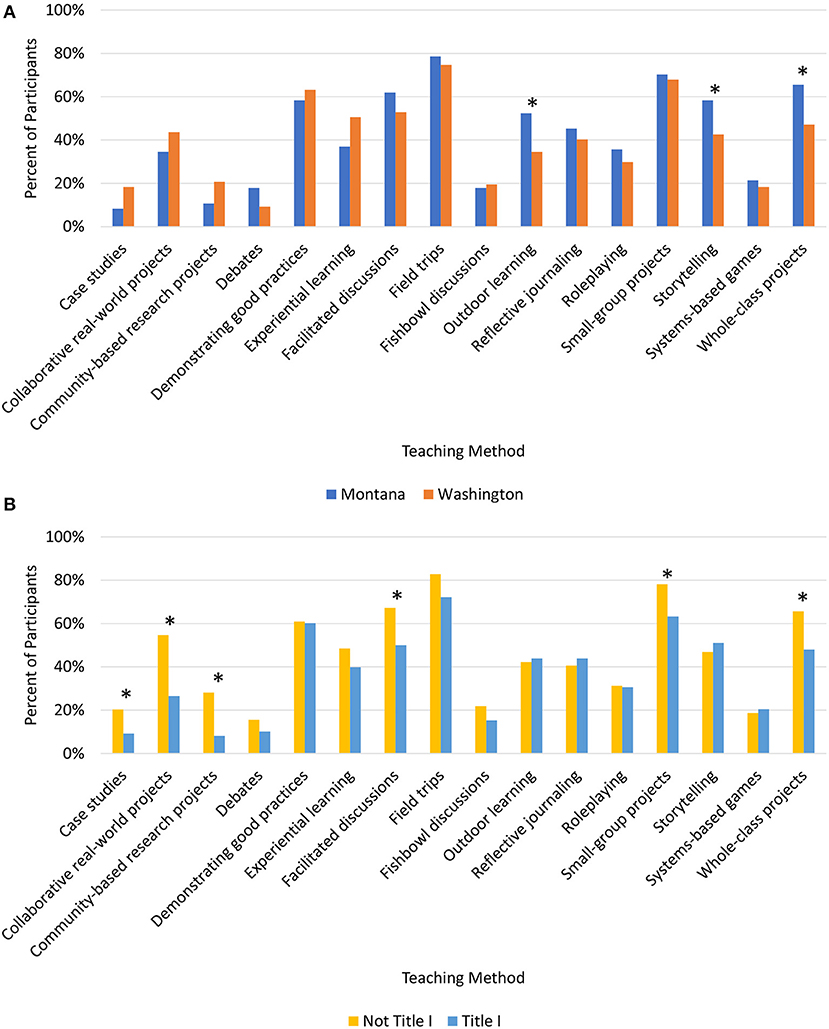
Figure 1. The percent of participants in (A) Washington (n = 87) and Montana (n = 84) and in (B) Title I (n = 98) and non-Title I (n = 64) schools that use each teaching method in their classrooms. Asterisks represent significant differences. Case studies were described to teachers as “in-depth looks at particular people situations, or groups,” and systems-based games were described to teachers as “(games that allow students to see the interconnectedness of different players/elements.”
The teaching methods used by significantly different proportions of participants between Washington and Montana include outdoor learning (p = 0.0182), storytelling (p = 0.0388), and whole-class projects (p = 0.0156). Specifically, a greater proportion of participants in Montana used outdoor learning (52%), storytelling (58%), and whole-class projects (65%) in their classrooms, compared to teachers in Washington.
Additionally, four teaching methods were associated with grade level. Generally, participants that teach higher grade levels (4th and 5th) used collaborative real-world projects (p = 0.0019), debates (p < 0.0001), and small-group projects (p = 0.0499) more than participants that teach lower grade levels (K-2nd). However, participants that teach lower grade levels (K-2nd) tended to use storytelling (p < 0.0001) more often than those at higher grade levels (3rd-5th).
Six teaching methods differed by Title I status: case studies (p = 0.0432), collaborative real-world projects (p = 0.0003), community-based research projects (p = 0.0007), facilitated discussions (p = 0.0309), small-group projects (p = 0.0453), and whole-class projects (p = 0.0272; Figure 1B). In these six cases, these teaching methods were reported to be used significantly more often by teachers at non-Title I (n = 64) schools than those at Title I (n = 98) schools.
Content
Sustainability-Related Content
The most common content areas taught by Washington participants (n = 86) include local issues (50%), global issues (38%), and sustainable water use (37%; Figure 2A). In Washington, 22% of participants reported that the do not teach about any of the 11 content areas. Similarly, the sustainability content areas most commonly taught by Montana participants (n = 84) are local issues (44%); social, cultural, and environmental interconnectedness (36%); and sustainable water use (32%). In Montana, 21% of participants do not teach about any of the 11 sustainability-related content areas.
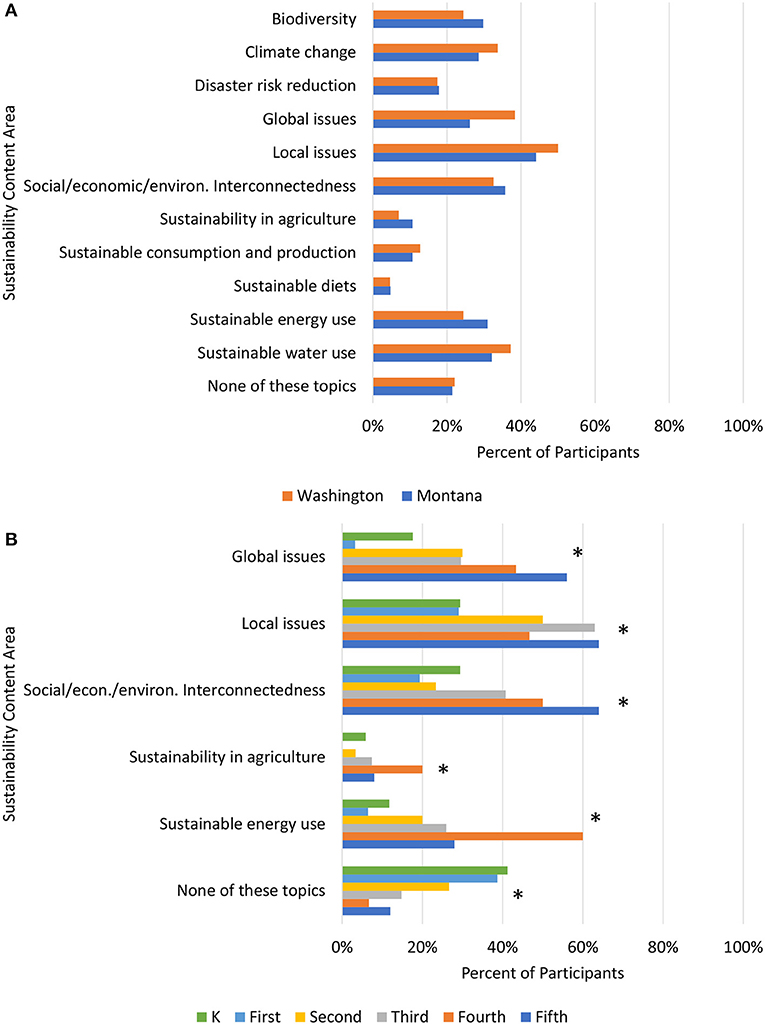
Figure 2. Percent of participants (A) from Washington (n = 86) and Montana (n = 84) and (B) that teach each grade level that report teaching about each sustainability-related content area (K n = 17, 1st n = 31, 2nd n = 30, 3rd n = 27, 4th n = 30, 5th n = 25). Asterisks represent significant differences.
While there were no significant differences between the proportions of participants from Washington and Montana that reported teaching each sustainability-related content area, there were differences among participants that teach different grade levels for several content areas. A larger proportion of participants that teach higher grade levels tended to teach about several topics than did teachers in lower grade levels, including climate change (p = 0.0004); global issues (p = 0.0004); local issues (p = 0.0366); social, cultural, economic, and environmental interconnectedness (p = 0.0045); and sustainable energy use (p < 0.0001; Figure 2B). Additionally, a larger proportion of participants that teach lower grade levels reported teaching about none of the sustainability-related content areas in their classrooms than did participants that teach higher grade levels (p = 0.0096).
The proportion of participants that reported teaching about sustainability-related content varied by Title I status for two of the content areas, global issues (p = 0.0177) and sustainable consumption and production (p = 0.0248). Participants that teach at non-Title I (n = 64) schools reported higher levels of instruction in both these content areas.
Sustainable Food Systems Content
The most common content areas taught by Washington educators who participated in the survey (n = 77) include food preferences (44%), the cultural importance of foods (38%), and the role of pollinators in the food system (36%; Figure 3). Montana educators who participated in the survey (n = 79) most commonly reported teaching about the role of pollinators in the food system (62%), local foods (53%), and food preferences (37%).
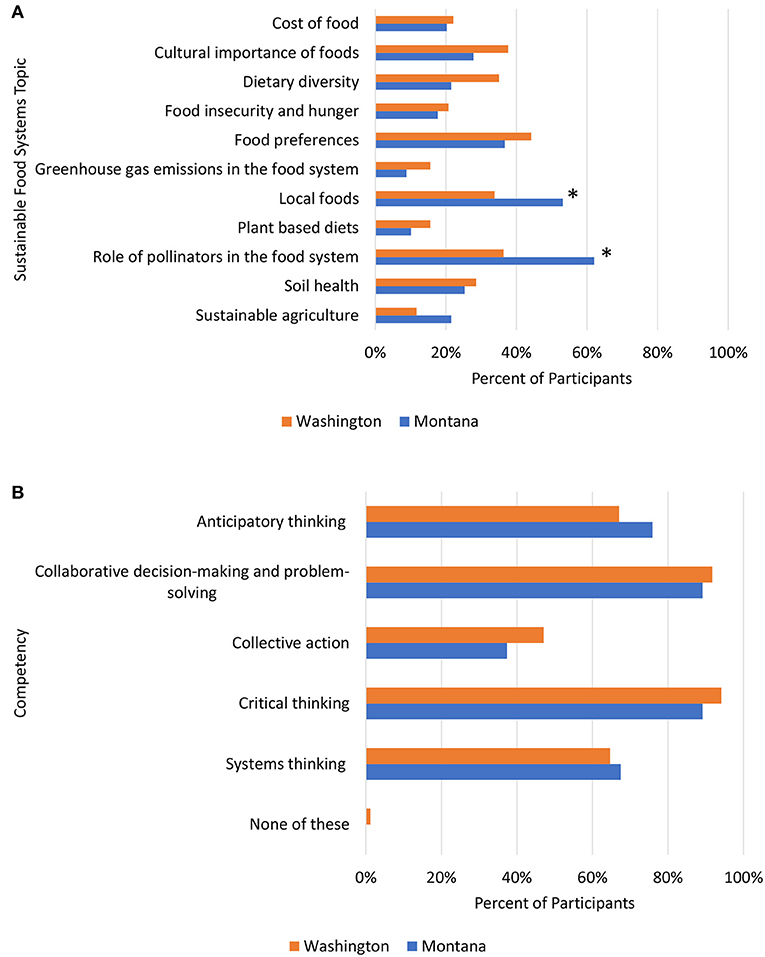
Figure 3. (A) The percent of participants from Washington (n = 77) and Montana (n = 79) that report teaching about each food systems content area. (B) The percent of participants from Washington (n = 85) and Montana (n = 83) that report striving to foster each competency in their students. Note: Anticipatory thinking was described to teachers as the “ability to understand future impacts of their actions.” Collective action was described to teachers as “using agency to collaborate to solve community problems.” Systems thinking was described to teachers as the “ability to understand that everything is interconnected.” Asterisks represent significant differences.
Significantly more participants from Montana reported teaching about local foods (p = 0.0146) and the role of pollinators in the food system (p = 0.0013) in their classrooms than did participants from Washington. Additionally, a larger proportion of participants that teach higher grade levels generally reported teaching about cultural importance of foods (p = 0.0131) and greenhouse gas emissions in the food system (p = 0.0089) than teachers of lower grade levels. There were no significant differences in the proportions of teachers that teach about sustainable food systems concepts based on their schools' Title I status.
Competencies
Of five competencies, participants from Washington (n = 85) and Montana (n = 83) most commonly reported trying to foster critical thinking (Washington 94.1%, Montana89.2%), collaborative decision-making (Washington 91.7%, Montana 89.2%), and anticipatory thinking (Washington 67.1%, Montana 75.9%) skills in their students (Figure 3B).
The proportions of participants that attempt to foster these competencies in their students did not vary by state or Title I status but did vary by grade level for the anticipatory thinking competency (p = 0.0025), with kindergarten teachers least often striving to teach this competency (data not shown).
Challenges
The most common challenges participants from Washington (n = 87) faced when trying to teach about sustainability-related content in their classrooms were a lack of knowledge about Washington's ESE Standards (77%), a lack of resources (e.g., lesson plans, books, videos, outdoor space; 60%), and too many sets of learning standards and too little time (54%; Figure 4). The most common challenges participants from Montana (n = 84) faced when teaching about sustainability-related content in their classrooms were too many sets of standards and too little time (57%), a lack of professional development to effectively teach these concepts (48%), and a lack of resources (e.g., lesson plans, books, videos, outdoor space; 42%).
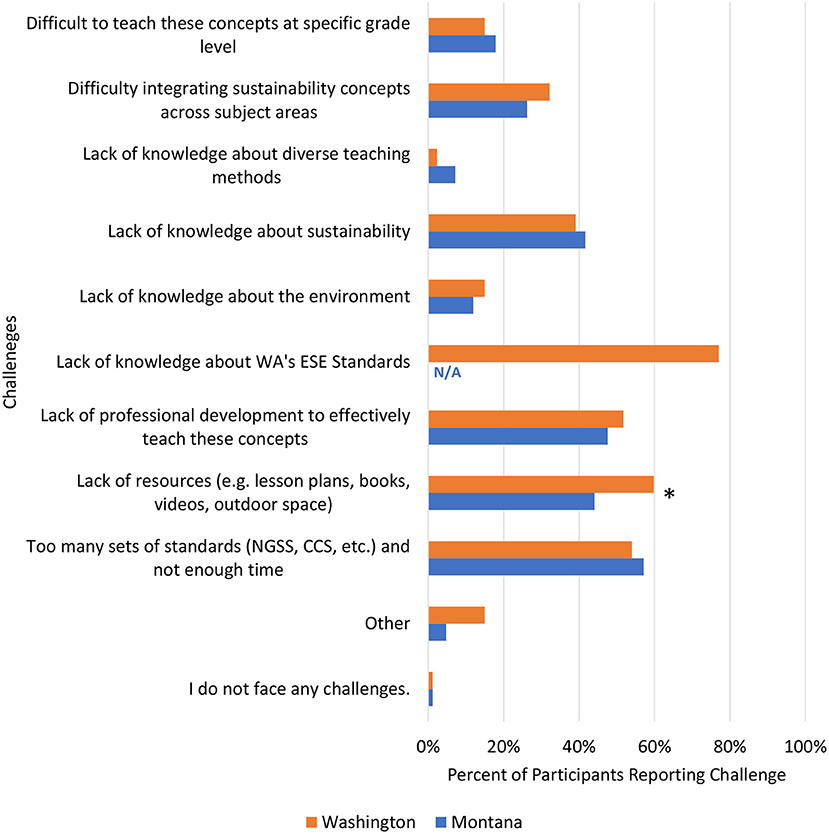
Figure 4. The percent of participants from Washington (n = 87) and Montana (n = 84) that report facing each challenge when trying to teach about sustainability in their classrooms. Asterisks represent significant differences.
The only challenge which participants from Washington and Montana reported experiencing in significantly different proportions was a lack of resources (e.g., lesson plans, books, videos, outdoor space; p = 0.0396), which more Washington participants reported experiencing (60%). There were no significant differences in the proportion of participants reporting each challenge based on grade level or Title I status.
Training
Relatively few participants from either state report having received training related to sustainability education (Figure 5). In Washington, 74.7% of participants (n = 87) and 71.4% of participants from Montana (n = 84) reported they have not received any training related to sustainability education. While a higher proportion of participants from Washington (4.6%) have received related professional development organized by a non-profit (p = 0.0467), a higher proportion of participants from Montana (16.7%) have received related professional development organized by their state or district (p = 0.0101). A small portion of participants (7.6%) mentioned other responses, most commonly personal research. Given the small sample sizes of teachers that have received training related to sustainability education, other demographic analyses were not performed.
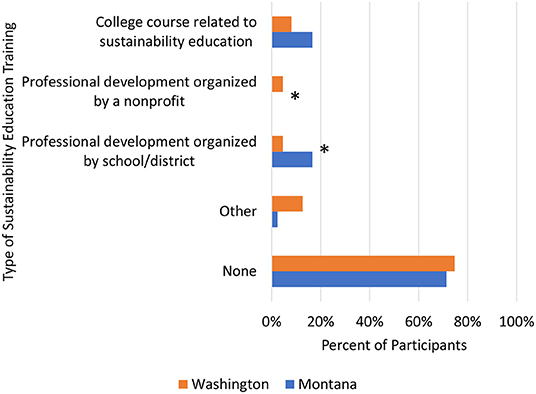
Figure 5. The percent of participants from Washington (n = 87) and Montana (n = 84) that report having received each type of training focused on teaching about sustainability. Asterisks represent significant differences.
Washington's ESE Standards
Document Analysis
The deductive framework for evaluating the presence of ESD and SFSE in Washington's ESE Standards (Wheeler et al., 2014) revealed that 50% of ESD and SFSE content areas are present in the ESE Standards. Content areas present in the Standards include: climate change, biodiversity, local and global issues, social/cultural/environmental/economic interconnectedness, and sustainable energy use. Content areas lacking in the Standards include: agriculture, sustainable diets, disaster risk reduction, sustainable consumption and production, and sustainable water use.
Eighty percent of ESD and SFSE pedagogies are present in the ESE Standards. Pedagogies which are present include: interactive and learner-centered, exploratory and action-oriented, inter and trans-disciplinary, and collaborative and participatory. The pedagogy lacking from the Standards is: self-directed and research based.
Finally, 100% of the competencies which are central to ESD and the SFSE signature pedagogy are present in the ESE Standards. These include: collaborative decision-making and problem-solving, systems thinking, critical thinking, anticipatory thinking (able to understand future impacts of their actions), and collective action (using agency to collaborate to solve community sustainability problems).
Sustainability Definition
Qualitative coding of respondents' definitions of “sustainability” revealed six themes (Figure 6). Four of these themes are also present in the definition of sustainability included in the ESE Standards (economics, environment, future generations' needs, and meeting current populations' needs), while two are not (able to be maintained over time and renewable/responsible resource use). The only theme included in sustainability definitions by different proportions of participants from Washington (n = 85) and Montana (n = 83) was economics (p = 0.0417), which Montana participants included more frequently. There were no significant differences between themes based on grade level or school's Title I status.
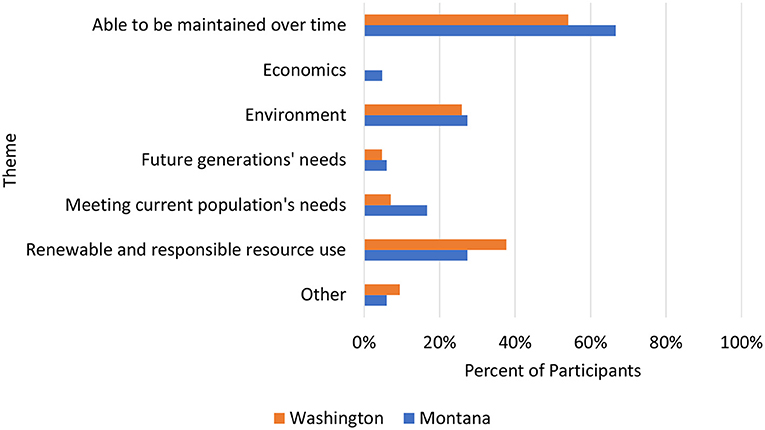
Figure 6. The percent of participants from Washington (n = 85) and Montana (n = 83) whose definitions of sustainability contained each of the six identified themes.
Knowledge and Implementation of Standards
When asked how much they knew about Washington's ESE Standards, 79% of participants from Washington (n = 86) reported knowing “nothing at all,” 20% reported knowing “a little to moderate amount,” and 1% reported knowing “a lot.”
After being shown the three ESE Standards, Washington teachers ranked on a scale of one (not well at all) to five (extremely well) how well they think they meet each Standard in their classroom (Figure 7A). Participants from Washington (n = 75) ranked themselves, on average, at 1.97 for Standard 1, 2.13 for Standard 2, and 2.07 for Standard 3. The ESE Standards were also presented to participants from Montana, but were framed as three sustainability-related learning outcomes (Figure 7A). Participants from Montana (n = 78) ranked themselves (on a scale of 1–5), on average, at 2.44 for Standard 1, 2.55 for Standard 2, and 2.29 for Standard 3.
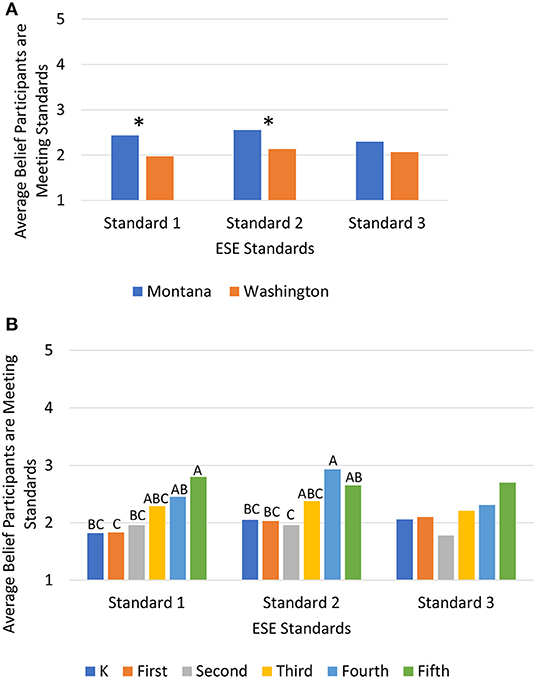
Figure 7. The average level of belief that participants (A) from Washington (n = 75) and Montana (n = 78) and (B) that teach each grade level are meeting the three ESE Standards (K n = 17, 1st n = 29, 2nd n = 27, 3rd n = 24, 4th n = 29, 5th n = 20). Asterisks represent significant differences, and grade levels not connected by the same letter are significantly different.
There are significant differences between how well participants from Washington and Montana believe that they meet Standard 1 (p = 0.0080) and Standard 2 (p = 0.0230). In both cases, participants from Montana believe they meet the Standards better than participants from Washington believe they do. Grade level is also significantly correlated with how well participants believe they meet Standard 1 (p = 0.0112) and Standard 2 (p = 0.0074) in their classrooms (Figure 7B). There were no significant differences in how well participants believe they meet the ESE Standards based on their schools' Title I status.
About 54% of participants (n = 77) were able to describe a lesson or activity they use to meet Standard 1 in their classrooms (Figure 8A). The most common content area was ecology (51.9%), and the most common teaching method was discussion (26.0%). “Other” content areas include soil, climate change, renewable resources, natural disasters, and others. “Other teaching” methods include collective action projects, drawing, games, STEM building, and others. Agriculture was the only theme which varied significantly between states (p = 0.0301), with more participants from Montana than Washington teaching about it. Additionally, the only theme which varied significantly based on Title I status was economics (p = 0.0177), which more non-Title I school participants described teaching about than did participants that teach at Title I schools (data not shown). There were no significant differences based on grade level taught.
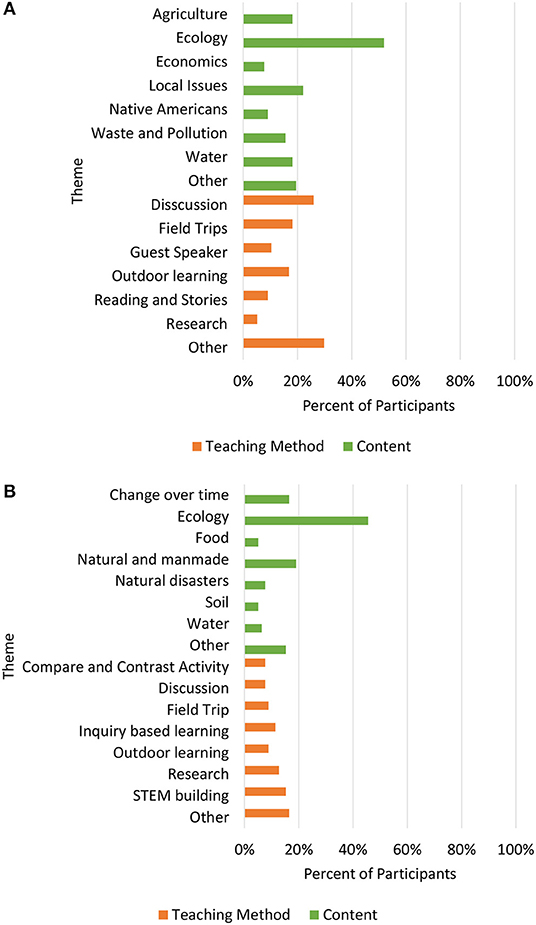
Figure 8. The percent of participants that mentioned each theme in their descriptions of an activity or lesson that they use to meet (A) Standard 1 (n = 77) and (B) Standard 2 (n = 79) in their classrooms.
About 56% of participants (n = 79) were able to describe a lesson or activity used to meet Standard 2 in their classrooms (Figure 8B). The most common content area was ecology (45.6%), and the most common teaching method was STEM building (15.2%). “Other” content areas include natural resources, pollution, recycling, Native American topics, and others. “Other” teaching methods include roleplaying, art projects, guest speakers, games, writing exercises, and others. Both ecology topics (p = 0.0028) and natural vs. manmade topics (p = 0.0164) were mentioned significantly more often by participants from Montana, while participants from Washington mentioned more “other” content areas (p = 0.0022). There were no significant differences based on grade taught or Title I status.
About 42% of participants (n = 59) were able to describe a lesson or activity used to meet Standard 3 in their classrooms (Figure 9). The most common content area was waste reduction (44.1%), and the most common teaching method was collective action (33.9%). “Other” content areas include soil, water, gardening, climate change, and others. “Other” teaching methods include art projects, outdoor learning, field trips, watching videos, and others. Both waste reduction topics (p = 0.0441) and collective action activities (p = 0.0058) were described significantly more often by participants from Montana than by participants from Washington. There were no significant differences based on grade taught or Title I status.
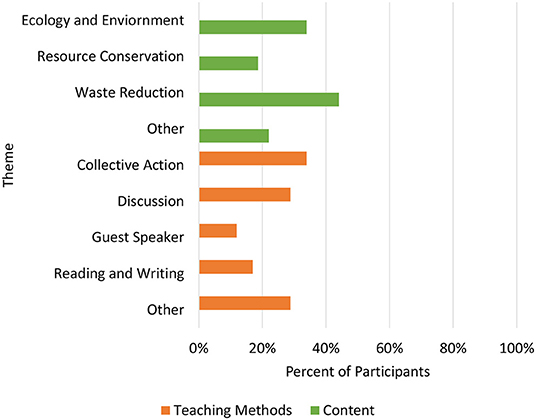
Figure 9. The percent of participants (n = 59) that mentioned each theme in their descriptions of an activity or lesson that they use to meet Standard 3 in their classrooms.
Discussion
Findings that 30% or less of the surveyed elementary school teachers in Washington and Montana integrate sustainability and food systems content in their classroom highlights the urgent need for reforming elementary school curriculum to integrate sustainability and food systems content. Given findings of the limitations of integrating sustainability due to limited time and resources, it is essential not to include sustainability as another curriculum topic. Rather, it is essential to view sustainability as a framework with which to approach other disciplines and content areas as well as to explore the linkages of these content areas. If utilized as a unifying and guiding framework, sustainability would be a central part of all of elementary school education rather than approached as an add-on. Resources would more likely be appropriately allocated to sustainability education including teacher training, curriculum materials, and funds. Additionally, implementation of a sustainability framework to guide elementary school education could elucidate synergies between other content areas while fostering systems thinking of both educators and students. Multiple organizations around the world are beginning to utilize sustainability frameworks to guide their missions; similarly, educational institutions can use sustainability to guide learning outcomes. In 2019, the 40th UNESCO General Conference adopted the new global framework on Education for Sustainable Development for the period of 2020-2030 to focus on integrating ESD into policies, learning environments, training educators, and empowering youth (UNESCO, 2019). Integration of such a sustainability framework to unify elementary school curriculum could overcome many of the limitations identified in this study with regards to integration of sustainability and foods systems content in the classroom.
This study further highlights that state learning standards focused on sustainability are not adequate for teacher adoption of sustainability content and require additional resources and approaches. The use of Education for Sustainable Development (ESD) related teaching methods, the focus on sustainability and food systems topics, and the effort to foster these competencies in their students did not generally vary based on the presence or absence of sustainability-related state learning standards. Findings that the proportion of respondents that teach about sustainability-related concepts did not vary based on state emphasize that factors in addition to the presence of sustainability-related state learning standards need to be taken into account including grade level, local culture, and access to the outdoors. In fact, despite Montana's lack of sustainability-related state learning standards, the surveyed Montana teachers implemented ESD and Sustainable Food Systems Education (SFSE) signature pedagogy teaching methods and content in their classrooms more often than those in Washington. In addition, differences in content taught were found between grade levels, which align with grade-appropriate content areas where higher grade levels cover more complex topics, such as global issues. There were not any differences in the delivery of sustainability and food systems content based on Title I Status, highlighting that sustainability and food systems content is accessible for all, despite the differences in available funding between Title I and non-Title I schools. While there is not a difference in delivery of content based on Title I status, comparisons cannot be made across other studies as there are few to no studies contrasting differences between Title I and non-Title I teaching methods.
While political affiliation and political ideology are recognized as key determinants of perceptions and behaviors associated with sustainability (Casper et al., 2021), they did not appear to have an impact on the responses of surveyed educators. For example, Casper et al. (2021) found that Democrats in the United States reported significantly higher values and norms associated with supporting environmental sustainability. Over the past decade, there has been a strong divide between “red” (conservative or Republican) states and “blue” (liberal or Democrat) states in the United States with regards to support over sustainability policies such as climate change and energy, rooting from ideological disagreements over the role of government intervention in the economy (Hess et al., 2016). A greater number of blue states (with majority of Democrat voters) have policies supporting environmental protectionism compared to red states (with majority of Republican voters). With Washington being a “blue” state and Montana being a “red” state, we expected variable perceptions and behavior with regards to sustainability education. The lack of differences found between the surveyed educators in Washington and Montana support previous research that while Democrats reported higher sustainability values, sustainability program engagement, awareness of sustainability initiatives, and influence of sustainability initiatives on behavior were politically neutral.
In addition, while differences were not found across states with and without sustainability-focused learning standards, we support that such standards provide a viable way to adapt ESD to local contexts. Despite the low rate of implementation of the ESE Standards by Washington elementary school teachers, examination of the ESE Standards highlight they provide an example of how to adapt ESD to a local context of US public education. Findings indicate that Washington's ESE Standards contain 50% of ESD and SFSE content areas, 80% percent of ESD and SFSE teaching methods, and 100% of the competencies which are central to ESD and the SFSE Signature Pedagogy. Sustainability-focused standards along with supplementary teacher training and resources are required to facilitate the integration of sustainability in the classroom.
On the basis of findings, sustainability and foods systems content that seem most accessible to integrate into the elementary school classroom includes pollinators, local foods, local issues, and sustainable water use. Although the proportion of respondents that are teaching about sustainability concepts in both Washington and Montana are fairly low, there was a greater use of student-centered teaching methods that are recommended for the integration of ESD into a curriculum by the surveyed educators from both states. Based on the prevalent teaching methods, field trips, small-group projects, and demonstrating good practices for students may be effective and accessible ways to integrate sustainability content in the classroom in order to foster critical and systems thinking, collaborative decision-making, problem-solving, and anticipatory thinking.
Only three of the 15 teaching methods aligned to ESF varied in this study based on the presence of sustainability-related state learning standards including outdoor learning, storytelling, and whole-class projects. These three methods were used more often by participants from Montana, indicating that factors other than the presence of sustainability-related state learning standards impact the use of ESD-aligned teaching methods including local cultural norms and environmental ethics. For example, Montana has seven tribal reservations where storytelling is associated as an Indigenous pedagogy (McKeough et al., 2008). Additionally, findings of variation of the implementation of teaching methods based on grade level are aligned with grade-appropriateness of different teaching methods. Further, findings that indicate that teaching methods used more often by participants that teach at non-Title I schools than by those at Title I schools indicate training and resource requirements to implement specific student-centered and interactive teaching methods that align with ESD. It is unknown if these finding are unique to this study as comparisons among other studies are difficult to make since there are few to no studies that contrast differences between Title I and non-Title I teaching and delivery methods. While educators are using a wide range of interactive teaching methods in their classrooms, additional training and support integrating interactive teaching methods could facilitate teachers to meet the goals of ESD.
The multiple limitations that were identified in this study with regards to integrating sustainability in the classroom (including a lack of resources (e.g., lesson plans, outdoor space, books), too many education standards, lack of professional development to teach about sustainability, multiple definitions of sustainability, and not enough time to teach about sustainability) can inform evidence-based actions to support education aligned with ESD including the implementation of sustainability as a unifying framework for elementary school education. For example, findings that ~80% of participants from Washington report that they know “nothing at all” about Washington's ESE Standards indicates the need for widespread professional development for educators on sustainability as well as clear communication on sustainability.
Widespread teacher training would ensure that all teachers have the foundational knowledge needed to teach about sustainability topics and engage their students through a wide range of interactive pedagogies. It would also ensure that teachers know where to find the appropriate resources to integrate sustainability education into their current curriculum in a transdisciplinary way. Existing research provides insight into how successful ESD-related professional development programs and ESD-focused teacher training programs can be structured and implemented (Mckeown, 2012; Nolet, 2013; The Bamber et al., 2016; Redman et al., 2018; Brandt et al., 2019). There are ESD-related professional development programs and ESD-focused teacher training programs around the country which provide a useful baseline for states that are interested in adopting larger-scale training programs.
While economic constraints may hinder professional development, access to resources has fewer economic constraints. We thus recommend the development of teacher resources be made widely available that describe how teachers at each grade level can meet each sustainability-related standard within other lessons that already meet other existing learning standards. Particularly, resources are needed for teachers at lower grade levels (K-2), who reported teaching about sustainability content less frequently than did teachers at higher grade levels (3–5). In addition, if sustainability is implemented as a unifying framework for elementary school education, it will be a priority for funding and professional development. Likewise, implementing sustainability as a unifying framework for elementary school education would overcome the challenge that the surveyed educators variably define sustainability. Educators will not be able to effectively implement ESD, the SFSE signature pedagogy, or sustainability-related state learning standards if their definitions of sustainability do not align with globally prevalent definitions such as that of the United Nations. We recommend that professional development programs aligning future teachers' definitions of sustainability with the UN's definition.
The challenge of overcoming too many required learning standards and not enough time to cover all content aligns with what others in the field of sustainability education have found (Church and Skelton, 2010). Among the most commonly cited reason why sustainability education has not been adopted throughout the United States is the lack of time for teachers to teach about sustainability, given an already full curriculum with other content (Church and Skelton, 2010). However, ESD and the ESE standards are intended to be implemented in a trans- and inter-disciplinary way (UNESCO, 2012; Wheeler et al., 2014). The integration of sustainability as a framework aligned with existing standards at each grade level would overcome the need for extra time for sustainability content.
Overall, on the basis of findings, we recommend the following evidence-based actions at the elementary school level to equip future consumers and leaders with the systems thinking skills, real-world experiences, and knowledge to make decisions and lead progress toward sustainability transitions:
1. Reform elementary school education with sustainability as a central framework. We call for urgent reformation of elementary school education where sustainability is a central unifying framework to approach all disciplinary areas as well as to explore connections between these areas. Sustainability is central for the well-being of society and the planet and should be approached as such across the curriculum at all grade levels and in terms of prioritization of resources. In particular, we urge for sustainability not to be approached as an add-on to curriculum. Integration of a sustainability framework to unify elementary school curriculum could overcome many of the limitations identified in this study with regards to integration of sustainability in the classroom.
2. Develop a diversity of professional development resources and lesson plans on sustainability that are widely accessible to all educators. There is a need to develop sustainability resources for educators that teach at various grade levels and subject areas including science, social studies, math, art, music etc. There is a further need to develop sustainability lesson plans for different disciplinary areas that are appropriately scaffolded in complexity across grade levels that align to the learning standards and outcomes of those levels and areas so that sustainability remains a central tenant of all curricula at all levels. Sustainability is a complex topic and appropriate scaffolding will be essential across grade levels. In addition, sustainability resources should be adaptable to be place-based and context-specific to different locations to highlight local sustainability challenges and solutions. Such resources should be made centrally available and sharable between educators through an online platform.
3. Provide open access continuous professional development on sustainability for all educators. Given economic constraints of professional development, we encourage open access and continuous professional development on sustainability for all educators. Trainings can begin by educating teachers about sustainability and food systems concepts as a foundation and then they can transition to educating teachers on how to engage students on these topics. We encourage school districts and state education agencies to collaborate with non-profit organizations to ease the burden of developing resources and supporting teachers.
Conclusion
This study highlights the urgent need for reforming elementary school curriculum to integrate sustainability as a central unifying framework to support societal and planetary health. Findings emphasize that state learning standards focused on sustainability are not adequate on their own to foster teacher adoption of sustainability content; rather, there is need for larger curriculum reformation to integrate sustainability as a framework, development of place-based teacher resources on sustainability, and open access professional development alongside learning standards. Such approaches would help overcome the multiple challenges which need to be addressed in tandem with the creation of learning standards in order to ensure that all students cultivate the systems thinking skills, real world experience, and sustainability knowledge that will allow them to develop the competencies to ultimately guide society toward meeting the SDGs. Through coordinated efforts between educators, state education officials, academics, and non-profit organizations there is potential to provide the widespread training and resources that educators need in order to successfully adapt ESD and the SFSE signature pedagogy into elementary education.
Data Availability Statement
The raw data supporting the conclusions of this article will be made available by the authors, without undue reservation.
Ethics Statement
The studies involving human participants were reviewed and approved by IRB at Montana State University. The patients/participants provided their written informed consent to participate in this study.
Author Contributions
AS, SAh, CB, and SAr contributed to the study design and development of the survey tool. AS led data collection and data analysis with contributions from TW and led the preparation of the manuscript with contributions from all authors. All authors contributed to the article and approved the submitted version.
Funding
Funding for this publication was provided by NSF RII Track-2 FEC OIA 1632810.
Author Disclaimer
The content is solely the responsibility of the authors and does not necessarily represent the official views of the National Science Foundation.
Conflict of Interest
The authors declare that the research was conducted in the absence of any commercial or financial relationships that could be construed as a potential conflict of interest.
Publisher's Note
All claims expressed in this article are solely those of the authors and do not necessarily represent those of their affiliated organizations, or those of the publisher, the editors and the reviewers. Any product that may be evaluated in this article, or claim that may be made by its manufacturer, is not guaranteed or endorsed by the publisher.
Acknowledgments
We are grateful to all of the educators that participated in this study and shared their perspectives and practices.
Supplementary Material
The Supplementary Material for this article can be found online at: https://www.frontiersin.org/articles/10.3389/fsufs.2021.714226/full#supplementary-material
References
Berkes, F., and Folke, C. (1998). Linking social and ecological systems for resilience and sustainability. Link. Soc. Ecol. Syst. 1:4.
Bowen, G. A. (2009). Document analysis as a qualitative research method. Qual. Res. J. 9:27. doi: 10.3316/QRJ0902027
Brandt, J.-O., Bürgener, L., Barth, M., and Redman, A. (2019). Becoming a competent teacher in education for sustainable development. Int. J. Sustainab. Higher Educ. 20, 630–653. doi: 10.1108/IJSHE-10-2018-0183
Bronfenbrenner, U. (1977). Toward an experimental ecology of human development. Am. Psychol. 32:513. doi: 10.1037/0003-066X.32.7.513
Bronfenbrenner, U. (1986). Ecology of the family as a context for human development: Research perspectives. Dev. Psychol. 22:723. doi: 10.1037/0012-1649.22.6.723
Casper, J. M., McCullough, B. P., and Smith, D. M. K. (2021). Pro-environmental sustainability and political affiliation: an examination of USA college sport sustainability efforts. Int. J. Environ. Res. Public Health. 18:5840. doi: 10.3390/ijerph18115840
Church, W., and Skelton, L. (2010). Sustainability education in K-12 classrooms. J. Sustainabil. Educ. 1, 1–13.
Cotton, D., and Winter, J. (2010). “It's not just bits of paper and light bulbs': a review of sustainability pedagogies and their potential for use in higher education,” in Sustainability Education, ed S. Sterling (London: Routledge). doi: 10.4324/9781849776516
Food Agriculture Organization (2019). The State of Food Security and Nutrition in the World 2019. Safeguarding Against Economic Slowdowns and Downturns. Rome: FAO. Available online at: http://www.fao.org/3/ca5162en/ca5162en.pdf (accessed September 6, 2021).
Gakidou, E., Afshin, A., Abajobir, A. A., Abate, K. H., Abbafati, C., Abbas, K. M., et al. (2017). Global, regional, and national comparative risk assessment of 84 behavioural, environmental and occupational, and metabolic risks or clusters of risks, 1990-2016: a systematic analysis for the Global Burden of Disease Study 2016. Lancet. 390, 1345–1422. doi: 10.1016/S0140-6736(17)32366-8
Hess, D. J., Mai, Q. D., and Brown, K. P. (2016). Red states, green laws: Ideology and renewable energy legislation in the United States. Energy Res. Soc. Sci. 11, 19–28. doi: 10.1016/j.erss.2015.08.007
Laurie, R., Nonoyama-Tarumi, Y., McKeown, R., and Hopkins, C. (2016). Contributions of education for sustainable development (ESD) to quality education: a synthesis of research. J. Educ. Sustain. Dev. 10, 226–242. doi: 10.1177/0973408216661442
Leicht, A., Heiss, J., and Byun, W. J. (2018). Issues and Trends in Education for Sustainable Development. Paris: UNESCO. Available online at: https://en.unesco.org/sites/default/files/issues_0.pdf (accessed September 6, 2021).
Mason, P., and Lang, T. (2017). Sustainable Diets: How Ecological Nutrition Can Transform Consumption and the Food System. Militon Park: Routledge.
McKeough, A. M., Bird, S., Tourigny, E., Romaine, A., Graham, S., Ottmann, J., et al. (2008). Storytelling as a Foundation to Literacy Development for Aboriginal Children: Culturally and Developmentally Appropriate Practices. Available online at: https://prism.ucalgary.ca/handle/1880/112019 (accessed September 6, 2021).
Mckeown, R. (2012). Teacher education 1992 and 2012: Reflecting on 20 years. J. Educ. Sustain. Dev. 6, 37–41. doi: 10.1177/097340821100600109
Montana Office of Public Instruction (2020a). Advanced Directory of Montana Schools. Available online at: http://opi.mt.gov/AdvSearchSchoolDirectory (accessed September 6, 2021).
Montana Office of Public Instruction (2020b). Content Standards and Model Curriculum Guides. Available online at: http://opi.mt.gov/Educators/Teaching-Learning/K-12-Content-Standards-Revision (accessed September 6, 2021).
Montana Department of Agriculture (2019). Ag Facts. Available online at: agr.mt.gov/AgFacts (accessed September 6, 2021).
Nolet, V. (2013). “Teacher education and ESD in the United States: The vision, challenges, and implementation.” in: Schooling for Sustainable Development in Canada and the United States, eds R. McKeown, and V. Nolet (Dordrecht: Springer), 53–67. doi: 10.1007/978-94-007-4273-4_4
Redman, E., Wiek, A., and Redman, A. (2018). Continuing professional development in sustainability education for K-12 teachers: principles, programme, applications, outlook. J. Educ. Sustain. Dev. 12, 59–80. doi: 10.1177/2455133318777182
Saldaña, J. (2015). The Coding Manual for Qualitative Researchers. 3rd edn. Los Angeles, CA; London: SAGE Publications Ltd.
Sarabhai, K. V. (2015). ESD for sustainable development goals (SDGs). J. Educ. Sustain. Dev. 9, 121–123. doi: 10.1177/0973408215600601
Steffen, W., Richardson, K., Rockström, J., Cornell, S. E., Fetzer, I., Bennett, E. M., et al. (2015). Planetary boundaries: Guiding human development on a changing planet. Science 347:1259855. doi: 10.1126/science.1259855
Stoy, P. C., Ahmed, S., Jarchow, M., Rashford, B., Swanson, D., Albeke, S., et al. (2018). Opportunities and trade-offs among BECCS and the food, water, energy, biodiversity, and social systems nexus at regional scales. BioScience 68, 100–111. doi: 10.1093/biosci/bix145
The Bamber, P., Bullivant, A., Glover, A., King, B., and McCann, G. (2016). A comparative review of policy and practice for education for sustainable development/education for global citizenship (ESD/GC) in teacher education across the four nations of the UK. Manag. Educ. 30, 112–120. doi: 10.1177/0892020616653179
Tilbury, D. (2011). Education for Sustainable Development: An Expert Review of Processes and Learning. Paris: UNESCO. Available online at: http://unesdoc.unesco.org/images//001914/191442e.pdf (accessed September 6, 2021).
UNESCO (2012). Education for Sustainable Development Sourcebook. Paris: UNESCO Available online at: https://sustainabledevelopment.un.org/content/documents/926unesco9.pdf (accessed September 6, 2021).
UNESCO (2014). Roadmap for Implementing the Global Action Programme on Education for Sustainable Development. Paris: UNESCO. Available online at: https://sustainabledevelopment.un.org/index.php?page=viewandtype=400andnr=1674andmenu=35 (accessed September 6, 2021).
UNESCO (2019). UNESCO 40th General Conference Adopts a New Global Framework for Education for Sustainable Development for 2020-2030. Available online at: https://en.unesco.org/news/unesco-40th-general-conference-adopts-new-global-framework-education-sustainable-development (accessed September 6, 2021).
United Nations (2015). Transforming Our World: The 2030 Agenda for Sustainable Development. Available online at: https://sustainabledevelopment.un.org/content/documents/21252030%20Agenda%20for%20Sustainable%20Development%20web.pdf (accessed September 6, 2021).
United States Census Bureau (2012). 2010 Census of Population and Housing. Population and Housing Unit Counts. Washington, DC: U.S. Government Printing Office. Available online at: https://www.census.gov/prod/cen2010/cph-2-1.pdf (accessed September 6, 2021).
US Department of Education (2018). Title I, Part A Program. Available online at: https://www2.ed.gov/programs/titleiparta/index.html (accessed October 2, 2021).
Valley, W., Wittman, H., Jordan, N., Ahmed, S., and Galt, R. (2018). An emerging signature pedagogy for sustainable food systems education. Renew. Agric. Food Syst. 33, 467–480. doi: 10.1017/S1742170517000199
Walker, B., and Salt, D. (2012). Resilience Thinking: Sustaining Ecosystems and People in a changing world. 1st edn. Washington, DC: Island press.
Washington Department of Agriculture (2019). Agriculture: A Cornerstone of Washington's Economy. Available online at: agr.wa.gov/washington-agriculture (accessed September 6, 2021).
Washington Office of the Superintendent of Public Instruction (2020a). Education Directory. Available online at: https://eds.ospi.k12.wa.us/DirectoryEDS.aspx (accessed September 6, 2021).
Washington Office of the Superintendent of Public Instruction (2020b). Learning Standards and Instructional Materials. Available online at: https://www.k12.wa.us/student-success/learning-standards-instructional-materials (accessed September 6, 2021).
Wheeler, G., Vavrus, J., Dorn, R. I., Kanikeberg, K., and Burke, A. (2014). Washington State K-12 Integrated Environmental and Sustainability Education Learning Standards. Olympia, WA. Available online at: http://www.k12.wa.us/EnvironmentSustainability/pubdocs/ESEStandards.pdf (accessed September 6, 2021).
Willett, W., Rockström, J., Loken, B., Springmann, M., Lang, T., Vermeulen, S., et al. (2019). Food in the anthropocene: the EAT-lancet commission on healthy diets from sustainable food systems. Lancet 393, 447–492. doi: 10.1016/S0140-6736(18)31788-4
Wisconsin Department of Public Instruction (2018). Wisconsin Standards for Environmental Literacy and Sustainability. Available online at: https://dpi.wi.gov/sites/default/files/imce/standards/New%20pdfs/Wisconsin_Standards_for_Environmental_Literacy_and_Sustainability_2018.pdf (accessed September 6, 2021).
Witoszek, N. (2018). Teaching sustainability in Norway, China and Ghana: challenges to the UN programme. Environ. Educ. Res. 24, 831–844. doi: 10.1080/13504622.2017.1307944
World Commission on Environment and Development (1987). Our Common Future. Oxford: Oxford University Press.
World Health Organization (2020). Global Health Observatory (GHO) Data: Overweight and Obesity. Available online at: https://www.who.int/gho/ncd/risk_factors/overweight_text/en/ (accessed September 6, 2021).
Keywords: education for sustainable development (ESD), sustainability education, sustainable food systems education, learning standards, elementary education
Citation: Stewart AL, Ahmed S, Warne T, Byker Shanks C and Arnold S (2021) Educator Practices and Perceptions of Integrating Sustainability and Food Systems Concepts Into Elementary Education: Comparative Case Study in Two Northwestern States in the United States. Front. Sustain. Food Syst. 5:714226. doi: 10.3389/fsufs.2021.714226
Received: 24 May 2021; Accepted: 17 September 2021;
Published: 21 October 2021.
Edited by:
Sandra Brown, University of British Columbia, CanadaReviewed by:
Heidi Kloos, University of Cincinnati, United StatesJan W. Hopmans, University of California, Davis, United States
John Havlin, North Carolina State University, United States
Copyright © 2021 Stewart, Ahmed, Warne, Byker Shanks and Arnold. This is an open-access article distributed under the terms of the Creative Commons Attribution License (CC BY). The use, distribution or reproduction in other forums is permitted, provided the original author(s) and the copyright owner(s) are credited and that the original publication in this journal is cited, in accordance with accepted academic practice. No use, distribution or reproduction is permitted which does not comply with these terms.
*Correspondence: Selena Ahmed, c2VsZW5hLmFobWVkQG1vbnRhbmEuZWR1
 Alyssa L. Stewart
Alyssa L. Stewart Selena Ahmed
Selena Ahmed Teresa Warne
Teresa Warne Carmen Byker Shanks
Carmen Byker Shanks Shannon Arnold2
Shannon Arnold2